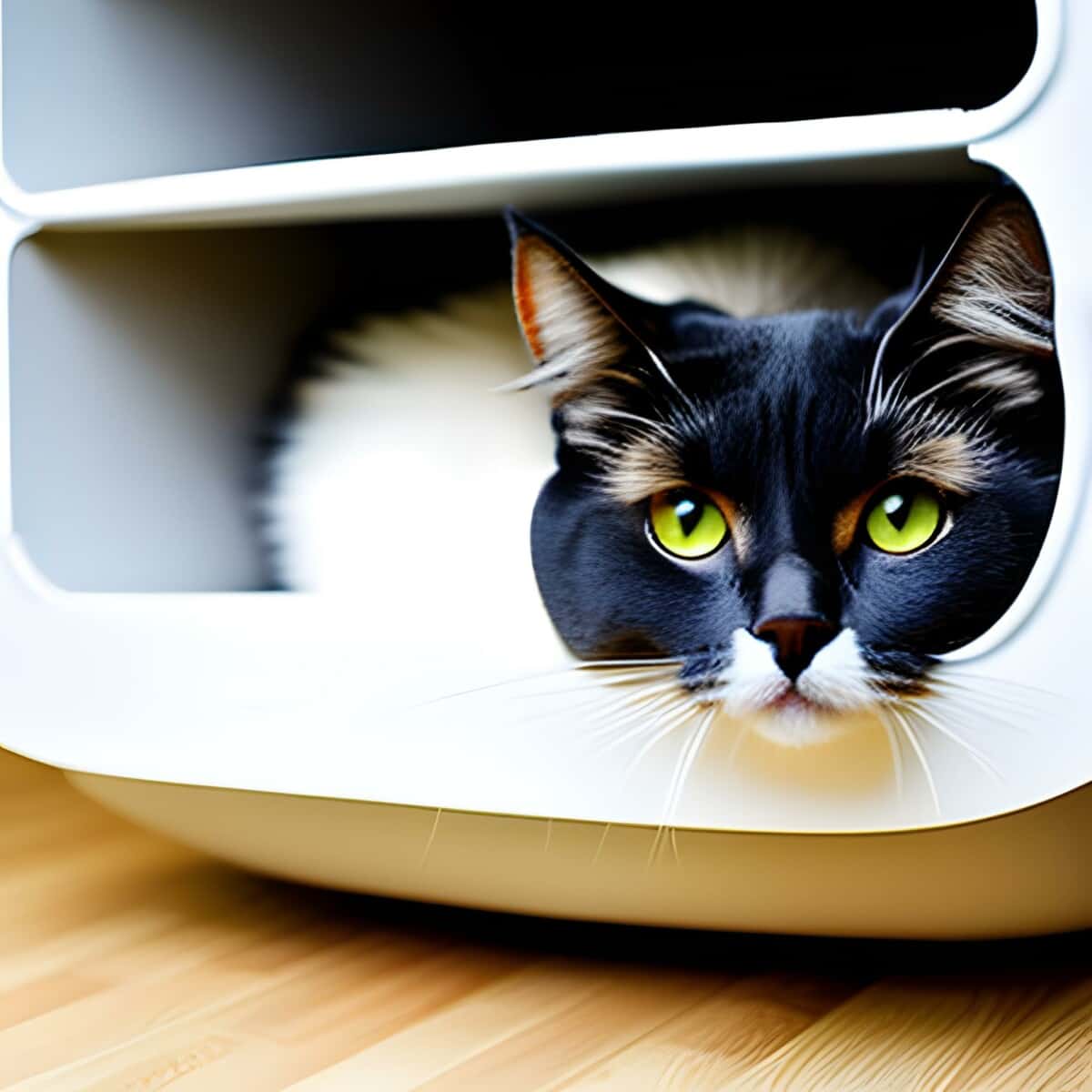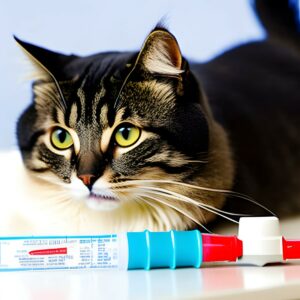George the cat is my next-door neighbor and I have been seeing him in the apartment hallway recently. His owner said he was asking to go out and she thought he was looking for a place to cool.
Since this was new behavior I asked about other changes. She said he looked tired and started gaining weight recently.
George was struggling with obesity, however, I felt his stomach and bladder. He exhibited signs of discomfort and unfortunately, his bladder seemed very hard on touch. so I suggested we take him for blood and urine tests.
Tests showed UTI but this is a great example of how cats hide pain and symptoms.
Behavioral changes are a sign to take your cat to the vet instead of waiting for other symptoms to develop.
George is fine now 🙂
In this comprehensive guide, we’ll explore everything you need to know about cat UTIs, from their causes and symptoms to diagnosing and treating such infections, as well as how to prevent future UTIs in your furry friend.
Cat UTI: Table of Contents
What is Cat UTI?
UTIs are painful and uncomfortable bacterial infections – if left untreated, they can lead to severe health complications and other health issues. Symptoms can include frequent urination, bloody urine, cloudy and smelly urine, loss of appetite, fever, etc.
UTIs occur when bacteria enter the urinary tract via the urethra and start multiplying.
The bacteria can come from the environment, fecal matter, or other sources.
Femail cats have a shorter urethra than males, making them more vulnerable to infections.
Certain factors, such as bladder stones or stress, can contribute to the development of infections. Female cats and cats with underlying medical conditions such as diabetes mellitus, obesity, and FIV are more susceptible to UTIs.
Poor hygiene can also be a cause of UTIs in cats. If the litter box is not cleaned regularly, it can become a breeding ground for bacteria.
Cat UTI Symptoms
If your cat has a UTI, you might notice some unusual behaviors or symptoms.
- Frequent urination: Cats may visit the litter box more often or show signs of discomfort while urinating.
- Straining to urinate: Cats may spend more time in the litter box with little to no urine produced.
- Painful urination: UTIs can cause discomfort or pain during urination, leading to vocalization or crying out while using the litter box.
- Blood in urine: Blood-tinged urine is a common sign of UTIs in cats. If you notice any discoloration in your cat’s urine, it’s important to consult a veterinarian.
- Urinating outside the litter box: Cats with UTIs may urinate outside their litter box, potentially due to associating pain or discomfort with the litter box itself.
- Excessive licking of genital area: Cats with UTIs may excessively groom their genital area in an attempt to alleviate discomfort or irritation.
- Urine odor: UTIs can cause changes in the smell of urine. If you notice a strong or unusual odor coming from your cat’s urine, it may indicate a UTI.
- Loss of appetite or lethargy
- Increased water intake
- Fever – it may be difficult to recognize fever in cats, so please read our guide on fever in cats.
Seek veterinary attention immediately if your cat displays any of these symptoms. UTIs can be painful and uncomfortable for cats, and if left untreated, they can lead to severe health complications such as kidney damage.
What Causes Cat UTI
In cats, UTi is caused by:
- Bacterial Infection
- Feline Lower Urinary Tract Disease (FLUTD)
- Bladder Stones
- Urethral Blockages
- Weakened Immune System
- Stress
- Anatomical Abnormalities
Bacterial Infection
The most common cause of UTIs in cats is a bacterial infection. Bacteria, such as Escherichia coli (E. coli), can enter through the cat’s urethra and settle in the bladder, leading to a urinary tract infection.
Common bacteria associated with cat UTIs include Escherichia coli, Staphylococcus spp., Proteus spp., Klebsiella spp., and Enterococcus spp.
Bacterial infections causing UTIs in cats are commonly seen in female cats older than 10 years of age.
Feline Lower Urinary Tract Disease (FLUTD)
Feline Lower Urinary Tract Disease (FLUTD) is a term that encompasses conditions affecting the lower urinary tract, including the bladder and urethra, in cats.
It is one of the most common reasons why cats visit veterinary practices.
The clinical signs of FLUTD may include:
- Difficult or painful urination
- Increased frequency of urination
- Crying out while urinating
- Blood in the urine
- Inappropriate urination (outside of the litter box)
- Frequent licking of the genital region
FLUTD can have multiple causes and is often challenging to identify the underlying reason.
It can occur at any age but is commonly seen in middle-aged, overweight cats that have little exercise, use an indoor litter box, have limited outdoor access, or eat a dry diet.
Some risk factors for FLUTD include being an indoor cat and living in a multi-cat household.
The disease can result from various factors such as urinary tract infections, bladder stones, urinary blockages, bladder cancer, or feline idiopathic cystitis (FIC), which refers to inflammation of the bladder with an unknown cause.
Environmental factors, stress, and diet may play a role in the development of FIC.
Diagnosing FLUTD requires a thorough examination by a veterinarian, including a review of the cat’s medical history, physical examination, urinalysis, blood work, and possibly imaging techniques like X-rays or ultrasounds.
Treatment for FLUTD depends on the underlying cause and may involve medications, dietary changes, environmental enrichment, and stress reduction techniques.
Bladder Stones in Cats
Bladder stones, also known as uroliths or urinary calculi, are mineralized formations that can develop in the urinary bladder of cats.
These stones can vary in size, shape, and composition, and they can cause various urinary problems, including UTIs.
When stones are present in the bladder, they can irritate the bladder lining, leading to inflammation and making the bladder more susceptible to bacterial infections.
Bacteria can adhere to the surface of the stones, forming a biofilm that protects them from the body’s natural defense mechanisms and antibiotics. This bacterial colonization can result in recurrent UTIs and persistent urinary symptoms.
Bladder stones in cats can result from a combination of factors, such as diet, genetics, and urine pH imbalances. Some of the most frequently observed types of bladder stones in cats include struvite stones, calcium oxalate stones, and urate stones.
The symptoms of bladder stones and associated UTIs in cats can vary but may include:
- Frequent urination
- Straining or discomfort during urination
- Blood in the urine
- Urinating outside the litter box
- Urinary accidents
- Lethargy or decreased appetite (in severe cases)
Diagnosing bladder stones and UTIs in cats usually involves a combination of physical examination, urinalysis, urine culture, and imaging techniques such as X-rays or ultrasound.
Treatment options depend on the size, number, and composition of the stones, as well as the presence of UTIs. In some cases, surgical removal of the stones may be necessary. Dietary management and modification may also be recommended to prevent the recurrence of bladder stones.
Urethral Blockages
Urethral blockages are a serious and life-threatening condition that typically affects male cats.
Male cats are more susceptible to urethral blockages because their urethra is longer and narrower than that of female cats
The urethra is the tube that carries urine from the bladder to the penis and out of the body. When the urethra becomes blocked, the cat is unable to urinate, leading to a buildup of urine in the bladder.
Urethral blockages in cats are most commonly caused by inflammatory material that obstructs the urethra, preventing the passage of urine. The blockage can be caused by crystals, mucus, blood clots, or stones.
UTIs themselves are not the primary cause of urethral blockages, but they can be a contributing factor in some cases.
The signs of a urethral blockage in cats include:
- Repeated attempts to urinate that are unproductive
- Crying or discomfort when straining to urinate
- Increased agitation and restlessness
- Licking of the genital area
- Lack of urine in the litter box
- Swollen or painful abdomen
- Vomiting or loss of appetite
Urethral blockages are considered emergencies because they can lead to life-threatening complications such as acute kidney failure.
Treatment for urethral blockages involves relieving the obstruction and addressing any underlying causes. This often requires the insertion of a urinary catheter to remove the blockage and allow urine to flow freely.
In severe cases or cases with recurring blockages, surgery may be necessary to remove bladder stones or address structural abnormalities.
Prevention of urethral blockages and UTIs in cats can involve a balanced diet, ensuring access to fresh water, maintaining litter box hygiene, and addressing any behavioral issues that may contribute to stress-related urinary problems.
Weakened Immune System
A weakened immune system can compromise the cat’s ability to fight off bacterial infections effectively, making them more susceptible to UTIs.
Here’s how a weakened immune system can contribute to UTIs in cats:
Reduced immune response: The immune system plays a vital role in recognizing and eliminating pathogens, including bacteria. When the immune system is weakened, its ability to mount an effective immune response against invading bacteria is compromised. This can allow bacteria to proliferate and cause infections in the urinary tract.
Impaired barrier function: The immune system helps maintain the integrity of the urinary tract lining, acting as a barrier against bacterial entry. A weakened immune system may result in a compromised barrier function, making it easier for bacteria to penetrate the urinary tract and cause infection.
Decreased ability to clear bacteria: The immune system helps in clearing bacteria from the urinary tract by activating immune cells and releasing antimicrobial substances. With a weakened immune system, the cat may have a diminished ability to eliminate bacteria efficiently, leading to persistent or recurrent UTIs.
Underlying health conditions: Certain medical conditions or diseases can weaken the immune system in cats. For example, congenital immunodeficiency disorders or viral infections like feline immunodeficiency virus (FIV) or feline leukemia virus (FeLV) can impair the cat’s immune response and make them more susceptible to infections, including UTIs.
Stress
Stress affects cats in much the same way it affects humans, and it can have a direct impact on their overall health, including their urinary system.
Cats are known for their ability to hide signs of pain effectively, but certain behavioral changes related to urination can be observed when they are stressed.
These changes may include urinating outside the litter box, straining while urinating, incontinence or loss of bladder control, and vocalizing in pain during urination.
The exact mechanism by which stress leads to UTIs in cats is not fully understood, but it is believed to involve interactions between environmental stressors, the neuroendocrine system, and the bladder. Stress can disrupt the normal functioning of the urinary system and weaken the cat’s immune response, making them more susceptible to infections.
Stress-induced inflammation of the bladder, or idiopathic cystitis, is a primary concern in cats with FLUTD.
Here are some common causes of stress in cats:
- Changes in the environment: Cats are known for their sensitivity to changes in their surroundings. Even subtle alterations such as rearranged furniture, moving to a new home, or introducing new pets or family members can cause stress for cats.
- Lack of routine and predictability: Cats are creatures of habit and prefer a structured routine. Disruptions in their daily schedule, inconsistent feeding times, or changes in their usual interactions with their owners can contribute to stress.
- Social conflicts: Cats are territorial animals, and conflicts with other cats or pets in the household can be a significant source of stress. Competition for resources, such as food, water, or litter boxes, can lead to stress and tension.
- Lack of vertical space: Cats are natural climbers and enjoy having access to high places. Insufficient vertical space or limited opportunities for climbing and perching can cause stress in cats, as they may feel unable to fully express their natural behaviors.
- Inadequate litter box conditions: Cats are generally clean animals and prefer a clean and easily accessible litter box. Dirty or overcrowded litter boxes, as well as sudden changes in litter type, location, or depth, can lead to stress and litter box aversion.
- Medical issues: Cats may exhibit signs of stress if they are experiencing underlying medical conditions or chronic pain. It’s important to rule out any physical health problems when a cat shows signs of stress.
- Loud noises and unfamiliar stimuli: Cats have sensitive hearing and can be easily startled or stressed by loud noises, such as fireworks, thunderstorms, or construction sounds. Similarly, unfamiliar people, animals, or objects in their environment can trigger stress responses.
- Common signs of stress in cats include changes in behavior, body language, appetite, grooming habits, and litter box usage.
Anatomical Abnormalities
Anatomical abnormalities in the urinary tract can create conditions that facilitate the colonization and growth of bacteria, leading to UTIs.
Here are a few examples of how anatomical abnormalities can contribute to UTIs in cats:
Urethral Structure: Cats, especially males, have a relatively narrow and longer urethra compared to other animals. This anatomical feature makes them more susceptible to urinary blockages and urine retention, which can increase the risk of bacterial growth and UTIs.
Diverticula (pouch-like structures) or strictures (narrowing), can create areas where bladder stones can form. These stones can act as a nidus for bacterial colonization, leading to UTIs.
Congenital Defects: Cats may be born with anatomical defects in their urinary system, such as ectopic ureters (abnormal placement of the ureter), which can lead to urine leakage and an increased risk of UTIs.
Abnormal Urinary Tract Development: Some cats may have abnormal development of their urinary tract, which can result in structural abnormalities. These abnormalities can disrupt the normal flow of urine, create urine pooling, or interfere with the bladder’s ability to empty fully, providing an environment conducive to bacterial growth and UTIs.
Anatomical abnormalities alone may not necessarily cause UTIs. They often interact with other factors such as bacterial infections, urinary stasis, or underlying diseases, increasing the likelihood of UTIs in affected cats.
Note: UTIs can occur in cats of any age, they are relatively uncommon. Only about 1-3% of cats with signs of urinary tract disease actually have a urinary tract infection.
Risk Factors for Cat UTIs
Several risk factors can increase the likelihood of your cat developing a UTI.
- Feline obesity: Overweight cats are more prone to developing UTIs as they have more skin folds, which can trap bacteria and increase the risk of infection.
- Feline urinary tract disease
- Feline immunodeficiency virus FIV
- Aging
- Female cats are also more susceptible to UTIs than males. This is because their urethra is shorter and wider, making it easier for bacteria to enter the urinary tract.
- Cats with bladder stones or cancer
Diagnosing a Cat UTI
If you suspect your cat has a UTI, don’t hesitate to take them to the vet.
Your veterinarian will perform a physical exam and may ask for a medical history to help diagnose the infection.
During the exam, your vet will check your cat’s vital signs, including their temperature, heart rate, and breathing.
They’ll also feel your cat’s bladder to assess whether it is full or if there is any discomfort. This information will help your vet determine the severity of the infection and the best course of treatment.
Urinalysis and Other Tests
The vet will typically perform a urinalysis to detect the presence of bacteria in the urine. This test involves collecting a urine sample and analyzing it for signs of infection.
A urine culture shows the type of bacteria and this will help decide the proper antibiotic for treatment.
Blood tests, x-rays, and ultrasounds may also be ordered to rule out other medical conditions, such as bladder stones or cancer. These tests will help your vet get an accurate diagnosis and develop an effective treatment plan.
Identifying the Underlying Cause
If your cat’s UTI is recurrent, your vet may investigate further to identify any underlying causes.
For example, Feline Immunodeficiency Virus (FIV) and diabetes mellitus can both increase the risk of UTIs. Treating these underlying conditions prevents future UTIs.
Cat UTI Treatment Options
Antibiotics are usually the first line of treatment for UTIs in cats. The veterinarian will prescribe a course of antibiotics to target the bacteria causing the infection.
Make sure to administer the antibiotics as prescribed, even if your cat shows improvement after a few days. Follow-up tests may be necessary to ensure the infection is entirely treated.
Pain Management and Supportive Care
Your vet may prescribe pain medication to keep your cat comfortable while undergoing treatment for UTI.
Make sure your cat has access to clean water at all times, and encourage them to drink more in order to help flush out the bacteria. If your cat is not drinking enough water, ask your vet about fluid therapy, which can be done at the vet clinic or at home under your supervision.
Vet Q&A
Q: Can cat UTI go away on its own?
A: Depending on the underlying cause a mild UTI may subside, however, bacterial infections tend to get worse – antibiotics eliminate the risk of further complications.
Q: How long can a cat survive a UTI?
A: UTI in cats is not fatal unless it is caused by severe health issues. The treatment is usually administered based on severity, it can last 7, 10, 14 days.
Q: What happens if cat UTI goes untreated?
A: If UTI is not treated it can cause blockages in the urethra, bladder rupture, and kidney failure. If UTI is not treated your cat can even die from complications.
My Senior Paws is a participant in the Amazon Services LLC Associates Program, an affiliate advertising program designed to provide a means for sites to earn advertising fees by advertising and linking to Amazon.com. We also participate in other affiliate programs which compensate us for referring traffic.




